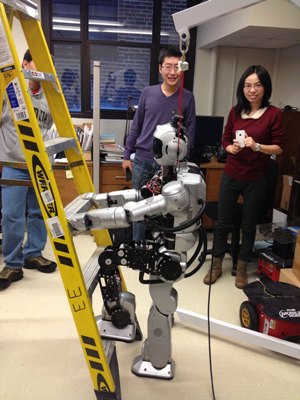Nov 8 2012
Researchers at Indiana University Bloomington's School of Informatics are part of an international team taking on the DARPA Robotics Challenge, a $2 million contest funded by the U.S. Defense Advanced Research Projects Agency to develop robots that can execute complex tasks in dangerous, degraded, human-engineered environments. The contest was inspired by the "Fukushima 50," the men who stayed behind at the Japanese plant to work to avert a nuclear meltdown following the earthquake and tsunami in 2011.
 IU Bloomington School of Informatics and Computing graduate students Yajia Zhang and Jingru Luo, from left in background, watch a robot prototype attempt to climb a ladder. Zhang and Luo will work with IU assistant professor Kris Hauser to develop software for a new robot prototype. (Courtesy of Indiana University)
IU Bloomington School of Informatics and Computing graduate students Yajia Zhang and Jingru Luo, from left in background, watch a robot prototype attempt to climb a ladder. Zhang and Luo will work with IU assistant professor Kris Hauser to develop software for a new robot prototype. (Courtesy of Indiana University)
Kris Hauser, an assistant professor of computer science who specializes in robot motion planning and control, semiautonomous robots, and integrating perception and planning, and two IU School of Informatics graduate students -- Yajia Zhang and Jingru Luo -- will collaborate regionally with Purdue University professor C.S. George Lee and three Purdue students on a 10-school team led by Drexel University.
The team, which also includes Columbia University, the University of Delaware, Georgia Institute of Technology, the Korea Advanced Institute of Science and Technology, Ohio State University, Swarthmore College and Worcester Polytechnic Institute, is one of seven being challenged to create both the robots and the software that will power them through tasks such as driving a vehicle (under the supervision of a remote operator), opening a door, climbing up a stairway and connecting a cable or a fire hose.
Hauser said the contest focuses on robots being able to utilize available human tools ranging from hand tools to vehicles, while also aiming to advance key robotic technologies of supervised autonomy, mounted mobility, dismounted mobility, dexterity, strength and platform endurance. Supervised autonomy is being developed to allow robot control by non-expert operators, to lower operator workload and to allow effective operation despite low fidelity communications affected by low bandwidth, high latency or intermittent signals.
"At one level our software figures out how to coordinate the robot's stepping and reaching motions so it remains balanced and energetically efficient, but at another level it makes strategic decisions about how to climb, like whether to step up one rung or two, or whether to grip the rungs or the rails," Hauser said. "The robot's software even considers exotic strategies like climbing backwards."
The software will also be used to help design new arms, hands, legs and sensors, by applying it to virtual robots in simulation where tests can be conducted automatically to determine how different mechanical design choices affect performance, before carrying out expensive and time-consuming processes of machining, assembling and testing new parts.
Hauser describes the problem of as one of playing a game of chess against nature.
"Like a chess player, a robot has the option of picking from several available moves and must think many steps ahead to make good choices," he said. "But unlike a chess match, in which each player has a fixed number of moves, a robot can move along an infinite number of trajectories, and nature has an infinite number of ways of surprising the robot -- a slippery floor, an unexpected obstacle or a gust of wind -- which makes this a fascinating and challenging research topic."
The portion of the competition that just began will last 15 months and culminate with a competitive challenge that will test a robot's ability to complete specific events related to disaster mitigation: mount, drive and dismount a vehicle; travel across rubble; remove debris; open a door, climb a ladder; use a tool to break through a concrete wall; locate and shut off a leaky valve; and remove and replace a pump. DARPA will then select teams to continue into a second phase that leads to another head-to-head competition one year later.
IU will receive $130,000 in funding for the first phase, and that total could rise to $251,152 if the team advances to the second phase.